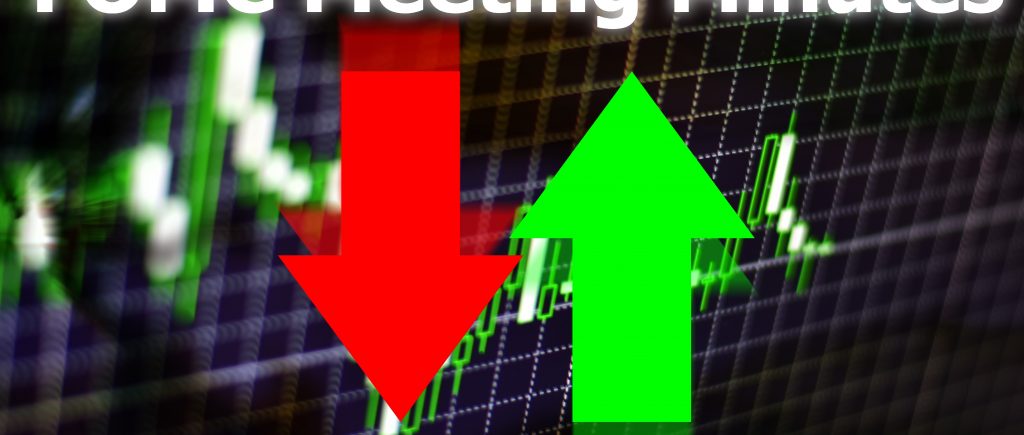Investors, traders and market participants are eying minutes of the Federal Reserve’s March meeting to find direction as well as to gauge US central bank policymakers’ appetite for a half percentage point increase in interest rates in May.
The stock market remains within a specific range for now, which should cause maximum frustration for everyone. So, when carefully checked, one could easily recognize this interesting pattern of conduct since November, most of the biggest rallies have followed the FOMC Meeting, while the biggest drops have followed the FOMC Minutes.
The Green Arrows point to FOMC meetings, while the Red Ones to FOMC Minutes. This may, in part, be because the actual FOMC meeting gives Fed Chair Jerome Powell the opportunity to soften the hawkish blows, while the minutes do not.
The CBOE Volatility Index is moving lower, ahead of a continued flow of economic data and the FOMC minutes on Wednesday afternoon. It is now at the lower end of the range. Moreover, a VIX under 20 will not provide the same fuel markets saw post FOMC to rocket the market higher unless the plan is for the opposite this time, with everyone rushing to buy puts after the FOMC minutes and pushing the market down.
Wednesday’s minutes will provide key details of the likely path forward on shrinking the Fed’s balance sheet. Fed Chair Jerome Powell said the plan will be laid out pretty clearly, hinting that policy makers debated an approach and came down in its favour.
The last time policymakers shrank the balance sheet, the Fed set caps allowing holdings to run off at $50 billion a month, namely $30 billion in Treasuries and $20 billion in mortgage-backed securities, phased in over a year, but officials have said they expect to go faster this time around.
In March, the Federal Open Market Committee raised its benchmark interest rate by just a quarter point against a backdrop of Russia’s war in Ukraine and the fastest inflation in four decades. Since then, price pressures have only escalated, and labour market data has shown solid employment growth and an obvious wage growth.
The United States added close to half a million jobs in March and the unemployment rate fell more than expected, according to government data on Friday. Those figures followed separate data showing a 6.4% jump in the personal expenditures price index, which the Fed uses for its inflation target.
March jobs report revealed that the labour market conditions continued to tighten. Nonfarm Payrolls rose by 431,000, the Labour Force Participation Rate stayed virtually unchanged at 62.4% and the annual wage inflation climbed to 5.6% from 5.2% in February.
Fed Governor Lael Brainard will participate in a Minneapolis Fed-hosted virtual discussion on inflation on Tuesday. It’s her first speech in months as she awaits Senate confirmation for the post of Fed vice chair. The US economic data calendar is light, with reports due on March services activity and the trade deficit for February.
The rapid absorption of unemployed into the job market could mean the Fed can hike rates steeply to combat inflation without raising unemployment, at least in the near-term.
traders are going to be eyeing the FOMC meeting minutes on Wednesday. Traders will be awaiting what is going to be in store for tapering the Fed balance sheet. The S&P 500 ended flat in a week when the central bank reduced its asset holdings. This could spell trouble for risk appetite in the coming months, leaving the US Dollar in a position to capitalize against Emerging Market currencies.
The US dollar has started the month of April on a firm footing on the back of the latest data releases from the US and rising odds of a 50 basis points (bps) Federal Reserve rate hike in May. The US Dollar Index, which tracks the dollar’s performance against a basket of six major currencies, is already up nearly 1% since the beginning of the month.
On March 16, the Fed decided to hike its policy rate by 25 bps to the 0.25%-0.5% range as expected. The Summary of Economic Projections, the so-called dot plot, revealed that the median view of the Fed funds rate at the end of 2022 was raised to 1.9% from 0.9% back in December. According to the dot plot, policymakers see the Fed hiking its policy rate by 25 bps at every meeting for the rest of the year.
Since the March meeting, however, conditions have changed and investors started to evaluate the prospects of double-dose rate hikes. The US Bureau of Economic Analysis reported on March 31 that the annual inflation, as measured by the Personal Consumption Expenditures (PCE) Price Index, climbed to 6.4% in February.
More importantly, the Core PCE Price Index, the Fed’s preferred gauge of inflation, rose to 5.4% from 5.2% in January. It is worth noting that the latest PCE inflation data do not reflect the impact of the Russia-Ukraine conflict and the coronavirus-related lockdowns in China on price pressures. It would be plausible to assume that inflation has more room to rise before finally starting to retreat.
Hawkish Or Dovish; That Is The Question!
At the post-FOMC press conference, FOMC Chairman Jerome Powell acknowledged that it was possible for the Fed to move rates up more quickly to tame inflation.
Several Fed policymakers, including Cleveland Fed President Loretta Mester and James Bullard, voiced their willingness to frontload rate increases to preserve the Fed’s credibility and ease price pressures. As it currently stands, the CME Group FedWatch Tool shows that markets are pricing in a 74.4% probability of a 50 bps rate hike in May.
The Fed may have backed itself into a 25-bps hike by dismissing the possibility of a 50-bps hike in its pre-meeting communication in March. In case the minutes show that policymakers considered a bigger rate hike but ended up voting for 25 bps to avoid a big market reaction, US Treasury bond yields could continue to rise and provide a boost to the dollar.
Market participants will also pay close attention to details surrounding the Fed’s plan to shrink the balance sheet. Powell noted that they will need to reduce the $8.9 trillion balance sheet to make sure high inflation does not become entrenched and NY Fed President John Williams said that policymakers could start doing that as early as May. The US dollar could continue to find demand if the publication unveils that policymakers are willing to make a large balance sheet reduction n the second half of 2022.
Alternatively; Policymakers are worried about a prolonged Russia-Ukraine conflict weighing on global economic activity. Powell, however, explained that they were more concerned about the impact of the crisis on inflation rather than growth.
A cautious language on future rate increases amid heightened uncertainty could be seen as a dovish development and trigger a dollar selloff.
DXY closed above the 20-day SMA on Monday after staying below that level in the previous three trading days. Confirming the bullish shift in the near-term technical outlook, the Relative Strength Index (RSI) indicator advanced to 60.
On the upside, 99.40 aligns as first resistance. With a daily close above that level, the index could target 100.00 (psychological level) and 100.40. In case the dollar faces selling pressure on a dovish surprise, DXY could drop to 97.80 (static level). If sellers manage to flip that level into resistance, further losses toward 97.30 (50-day SMA) and 96.70 (100-day SMA) could be witnessed.
Some observers believe that gold and silver prices are likely to remain down as rebound in the US dollar and rising bond yield, together, pressure precious metals. The US Fed has a hawkish outlook and FOMC meeting minutes can weigh on prices of precious metals.
Gold prices are a bit lower and silver prices a bit higher in early U.S. trading Tuesday, as the markets are pausing and awaiting fresh fundamental inputs to drive near-term price direction. That may come Wednesday afternoon with the release of the Fed’s FOMC minutes. June gold futures were last down $4.30 at $1,929.50 and May Comex silver was last up $0.185 at $24.775 per ounce.
Rising Covid cases in China are also of concern to the global marketplace, as is the specter of rising inflation. Traders will closely examine Wednesday afternoon’s release of the minutes from the last FOMC meeting of the Federal Reserve, for clues on the future trajectory of U.S. monetary policy and inflation trends.
 Noor Trends News, Technical Analysis, Educational Tools and Recommendations
Noor Trends News, Technical Analysis, Educational Tools and Recommendations





